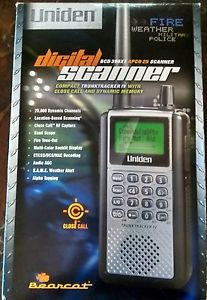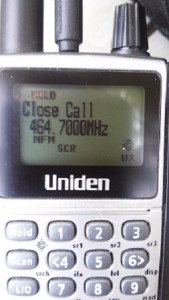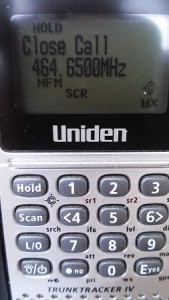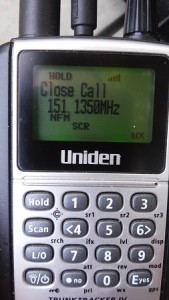I can think of some circumstances when I would really REALLY like to know if a radio is being keyed up (transmitting) in close proximity to me — say, within a few hundred feet. It could very well be that what someone close by is using a radio for, and discussing, could pertain to me. I’m not paranoid, I just want to have enough situational awareness to know if someone near me is talking about me on a radio.
I’ve been going what seems to be non-stop, so I promised my family some quality time. We went to the county fair on Thursday afternoon. And what is going to the fair without people watching?! My favorite part, right up there with Italian sausage and the rodeo with bull riding.
 I took the opportunity to take people watching to a new level, by people ‘listening’. The county fair provided a signals-rich environment for stretching the legs on my UnidenBearcat BCD 396XT and exclusively used the ‘Close Call’ feature of the scanner. Close Call is a feature you want to look for, and require, in your decision making process when purchasing a scanner. It should also have, at a minimum, APCO 25 (P25) digital decoding capabilities.
I took the opportunity to take people watching to a new level, by people ‘listening’. The county fair provided a signals-rich environment for stretching the legs on my UnidenBearcat BCD 396XT and exclusively used the ‘Close Call’ feature of the scanner. Close Call is a feature you want to look for, and require, in your decision making process when purchasing a scanner. It should also have, at a minimum, APCO 25 (P25) digital decoding capabilities.
Close Call (when activated) allows you to detect VHF and UHF signals that are transmitted within approximately 200 to 300 feet (or more) from your location, depending on the signal strength of the radio that is transmitting. The fairgrounds provided a great SIGINT (Signals Intelligence) training opportunity.
My objective was to use Close Call scanning to detect the frequencies being used in my vicinity. Once the scanner ‘catches’ a signal, it alerts you with a customizable ‘beep’ notification (or you can set to silent), the screen flashes, and on-screen instructs the user to ‘Press Any Key’ to display the frequency being transmitted.
 I also connected a double-ended 1/8″ audio patch cable from the headphone jack to the microphone ‘In’ jack on my Sony pocket Digital recorder. I could monitor the transmissions using the earbuds that I plugged into the headset jack in the digital recorder.
I also connected a double-ended 1/8″ audio patch cable from the headphone jack to the microphone ‘In’ jack on my Sony pocket Digital recorder. I could monitor the transmissions using the earbuds that I plugged into the headset jack in the digital recorder.
This is where it gets fun. The fairgrounds provided communications from law enforcement, emergency medical services, fair staff and volunteers, and citizens keeping track of each other (such as families and friends) using FRS family radios.
As the signals are intercepted and I receive an audio and visual indicator that a frequency has been found, I press the ‘Hold’ button which displays the frequency. I would normally write the frequency down, but in this case I simply took a picture of the scanner screen. This is important for scanning later. Remember, depending on the proximity of the parties talking to each other, you may only (and often) hear just one side of the conversation. Once you ‘Hold’ on that frequency, or store it in the receiver, you can hear all parties, even though the other radios may be miles away from you. At first however, while scanning in ‘Close Call’ mode, you only hear the signal(s) within Close Call range.
 When you press the ‘Hold’ button again, the receiver continues scanning for the next signal. You can press the ‘Hold’ button again to recall the previous signal, but if your close call picks up another (new) signal, the previous signal is gone (when using the mode I had it set to).
When you press the ‘Hold’ button again, the receiver continues scanning for the next signal. You can press the ‘Hold’ button again to recall the previous signal, but if your close call picks up another (new) signal, the previous signal is gone (when using the mode I had it set to).
Once you capture frequencies, you can then do your research to determine who (or what service) the frequency is assigned to.
For example, here are three of the frequencies detected by Close Call:
151.1350 MHz
464.7000 MHz
464.6500 MHz
Remember, Close Call only captures analog frequencies and does not decode the P-25 encoding. You must program the frequencies into the radio and enable P-25 decoding to hear those communiques.
You can take it a step further and look up the call signs on any number of online repeater directories to determine what agency, or entity, that frequency is assigned to. They don’t always show up in directories however. NOTE: If the intercepted radios are using repeaters, you may be detecting the repeater ‘Input’ frequency, which may be several MHz off from the ‘Output’ frequency of a local repeater. It is the OUTPUT frequency which is listed in directories. Occasionally you can find a directory which shows both the Input and Output frequencies (an optional feature you can select when using RadioReference.com, for example).
Try it some time! Go to a signals-rich environment and hone your SIGINT collections skills. And keep in mind, SIGINT is not the same as COMINT. Signals Intelligence is the intercept, collection, identification, and tracking of signals (frequencies, pl tones, modes, etc.) — WHAT and HOW signals are being transmitted. COMINT is Communications Intelligence — What they’re saying/talking about.
SIGINT – How
COMINT – What
Just for fun, I compiled just a small audio file of the traffic here. Bear in mind, in many cases I only captured the closest radio transmitting, which means I often caught only half of the conversation. Once a frequency is locked on and Close Call is paused, then I can hear all parties transmitting on the target/captured frequency. In the audio file (below) you’ll also notice the P-25 encoded traffic which has a ‘static-ish’ sound with a pulsating warbly tone at the end. The BCD 396XT can decode P-25, but not while in Close Call mode (if there’s a way around that, I’m unaware of it).
Oh, and yes I did spend quality time with my family. People watching and listening was part of it and we all enjoyed that part too.
Recommended Scanners with Close Call Capabilities:
Uniden Handheld TrunkTracker IV Digital Police Scanner (BCD396XT)
Uniden BCD436HP HomePatrol Series Digital Handheld Scanner
SIDE NOTE: We used Close Call to identify many of the frequencies being used by city and fire officials during the deployment to the Washington wildfires. It worked great.




You press the volume knob down, which enables “function”, and then press 9 “mod” until the modulation changes to P25. With Radioshack-Whistler scanners the Signal Stalker/Spectrum Sweeper will decode P25 since the default modulation is in “au” auto mode it just detects whatever type of modulation is used, am fm wfm p25 automatically.